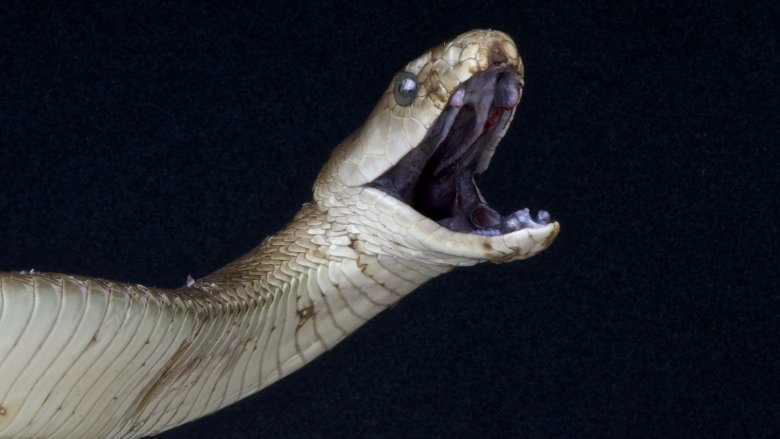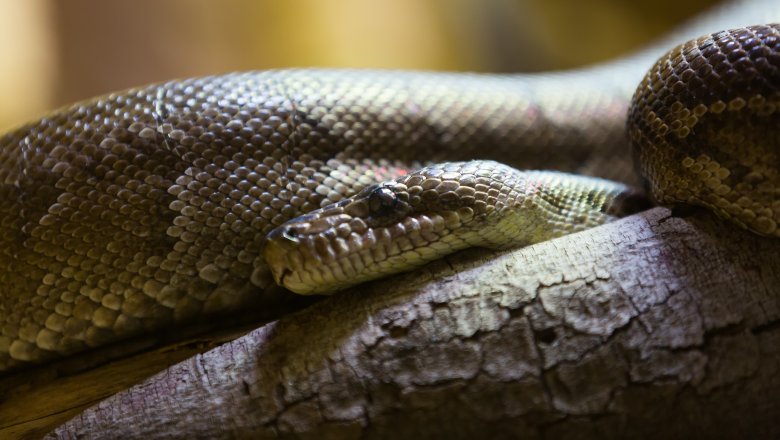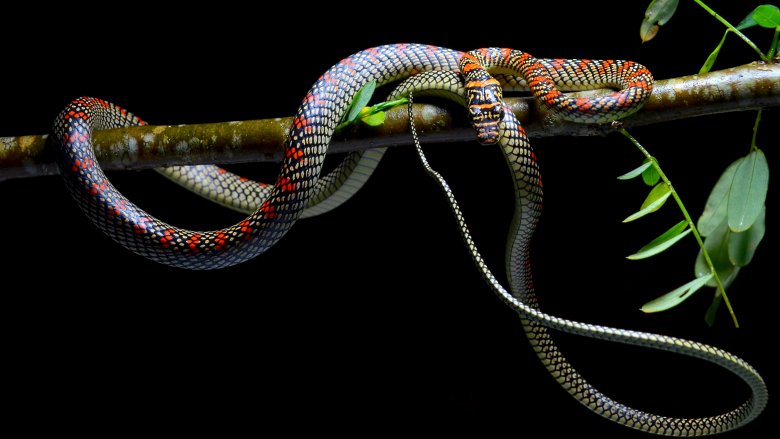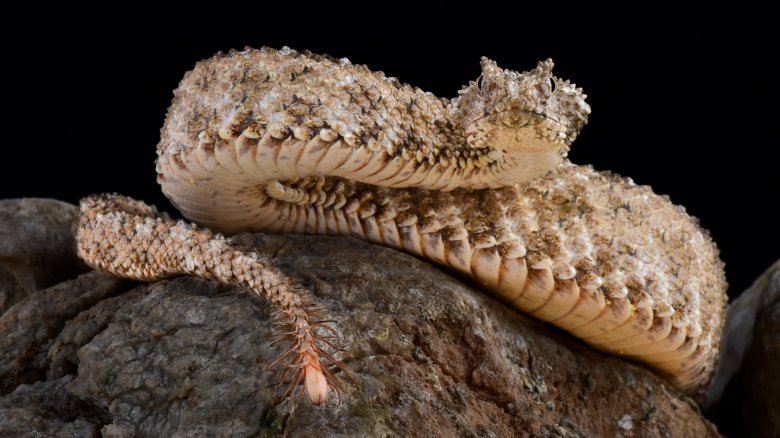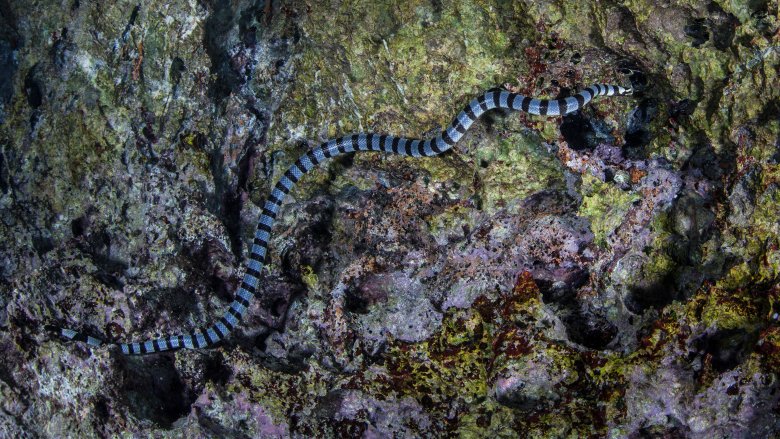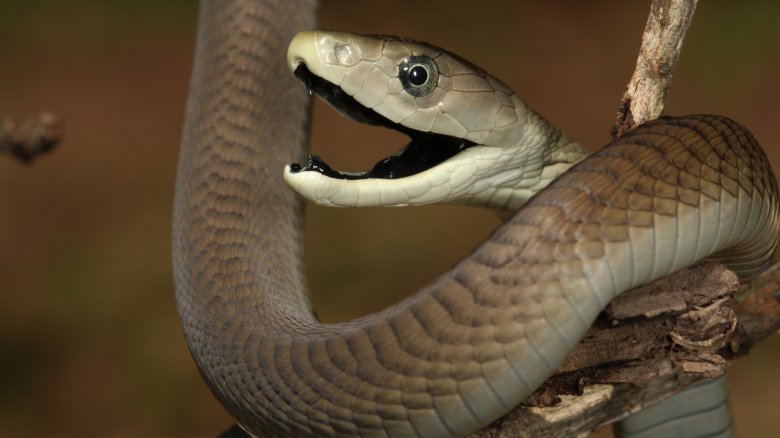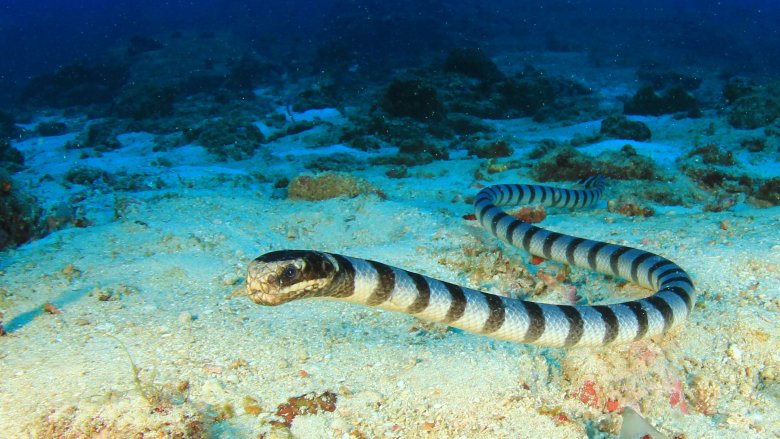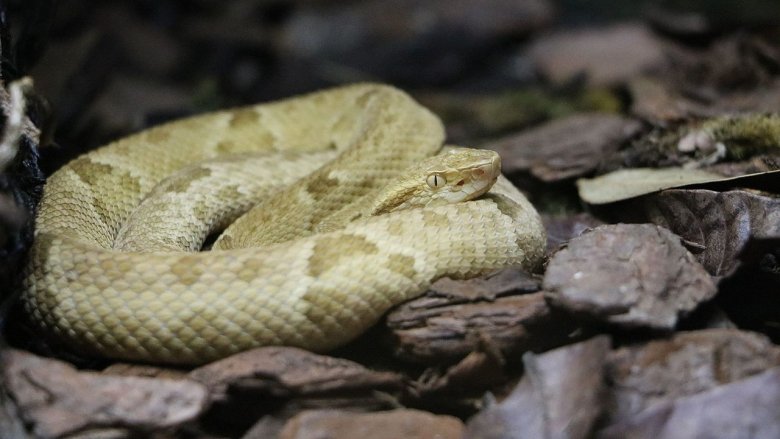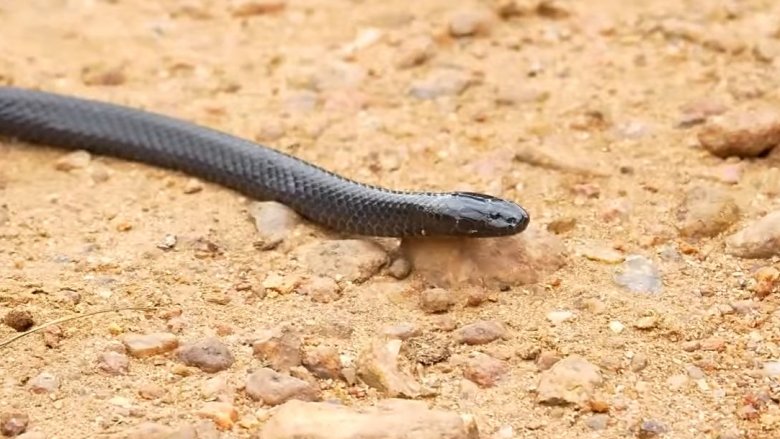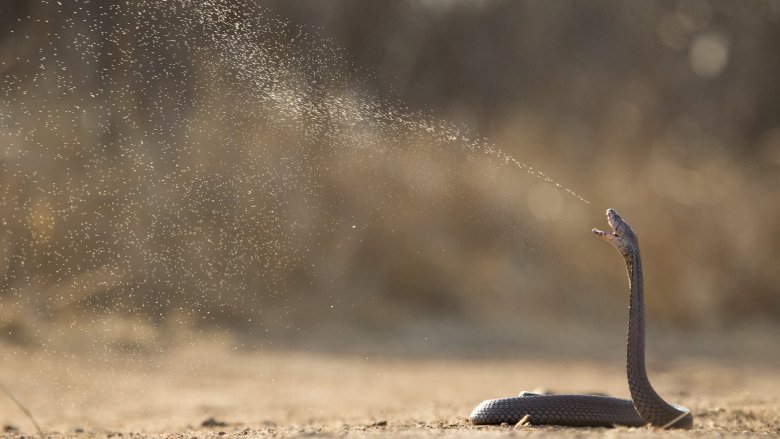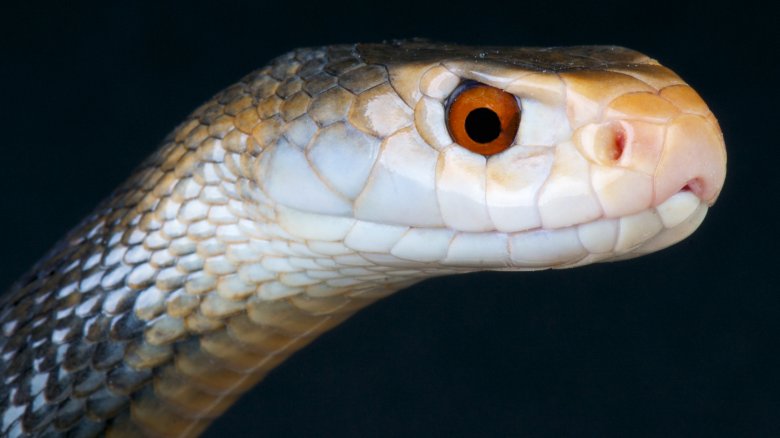The Most Terrifying Snakes In The World
To many, snakes are terrifying no matter what they are. Even the tiniest of garter snakes can send an otherwise-brave soul running for the hills. But not all snakes are created equal. While some are perfectly harmless, and even kind of cute, others are just plain freaky and scary, even for the biggest snake lover you know.
The Cuban boa
Snakes are bad enough when they hunt alone, but now, according to CNN, scientists have discovered a species of snake that prefers to hunt in packs. Yep, snake gangs — your worst nightmare come to life.
In May of 2017, a University of Tennessee scientist named Vladimir Dinets observed several specimens belonging to the Cuban boa species of snake gathering at caves and working as a group to catch fruit bats. They would strategically place themselves at the entrances of the caves, forming what's basically a wall of snakes, making it way harder for the bats to escape. And, to decrease the odds of the bats flying up high and zooming toward freedom, some of the snakes (some of which were as tall as an average human) would actually hang upside down from the cave's mouths and catch bats. They truly thought of everything.
So far, the Cuban boa is the only snake known to hunt this way — every other snake goes solo and without much strategy beyond "eat the thing now." But if the other snakes learn from their Cuban brethren, we've all got extra reason to fret — especially if we're anywhere near a cave.
Flying snakes
The very idea of a flying snake sounds too terrible to be true, like something Stephen King might dream up. But nope, they're real, because not even the skies are safe from those that slither.
Found mostly in Southeast Asia (according to National Geographic), the five known species of flying snakes don't truly fly, per se, but they can climb trees, most likely to escape predators. They use the wind to glide from there on. That said, if a particularly large gust of wind gets them, they basically fly, and anyone who sees it basically has to get a change of pants.
Luckily, these snakes aren't deadly to humans at all — they're venomous, but only mildly so, and their fangs are too tiny to do any real damage to us. But then, most spiders are harmless too, and we're still scared of them. No way will saying "the flying snakes can't actually kill you" stop people from freaking out about flying snakes.
Iranian spider-tailed viper
A spider-snake hybrid would probably cause more heart attacks than cholesterol, so it's a relief such a thing doesn't exist ... kind of. There is, in fact, a snake out there that pretends to be a spider. And even though it's not an actual snake-spider hybrid, it's still probably the last thing anyone wants to see.
As documented by National Geographic, the rarely-seen Iranian spider-tailed viper is exactly that — a snake with a tail that looks like a spider. That tail is actually a lure, much like the illuminated lure dangling from the head of an anglerfish. Yasouj University biologist Behzad Fathinia and his team noticed a viper doing this for the first time in 2015, and even filmed it (as seen above). Basically, the viper lies in wait, camouflaged among the rocks, shifting the spider-looking part of its tail this way and that, until its favorite food — birds, usually warblers — swoops down to munch. Then, within .2 seconds, the viper strikes, incapacitating the poor birdie and readying itself for a tasty meal.
Interestingly, this snake has only been its own species since 2006 — we've known it existed since 1968, but it was misclassified as a regular viper with a birth defect. In hindsight, those researchers were probably just in denial that such an unholy abomination exists.
Common Krait
The Common Krait doesn't sound or look like much of a threatening snake — until you realize how it attacks, and then you never, ever sleep again.
The Krait – as described by the study Neuromuscular Effects of Common Krait (Bungarus caeruleus) Envenoming in Sri Lanka – is mostly found in south Asia, and it mostly hunts at night. Thus, most of the snake's victims are sleeping when bitten. Unfortunately, this is not a case where you get chomped on the leg and wake up screaming. Nope — you're likely to not feel anything at all. The bite is so small and painless, you're likely to sleep like a baby through the whole ordeal.
That's a big problem, because the Krait's venom is rather strong, and can result in respiratory paralysis if untreated. And untreated is exactly what could happen if you sleep through the bite, dismiss the bite mark in the morning as "some damn mosquito," and not realize it's so much worse...until far too late.
Black Mamba
You've almost certainly heard of the black mamba and know it as a venomous, dangerous snake (or a dangerous, retired basketball player). But there's a chance you don't know the half of why the black mamba is so terrifying. It's basically a horror movie monster brought to life.
According to National Geographic, black mambas aren't actually black — they're typically brown. The black, as it happens, is found on the inside of their mouths. That's creepy enough, but when you really get one riled up, the nightmare truly begins.
The mamba, which can grow up to 14 feet long, readies itself for attack by raising a third of its body in the air, meaning this giant snake is now possibly staring you in the eye. Oh, and it's super-fast too, capable of reaching slither-speeds of over 12 miles an hour. You're not outrunning that, so don't even try. And when it bites you, it bites multiple times just to get the point across. Also, black mamba venom is super-potent and can kill within twenty minutes if not treated immediately.
About the only creatures who can hang with black mambas are mongooses, who are immune to snake venom. But if you're reading this, you're probably not a mongoose, so all we can say is "good luck."
Dubois' sea snake
Underwater creepy-crawlies are bad enough, what with the fanged, translucent fish and cartoonishly large jellyfish. But Mother Nature just had to go and create highly venomous snakes that are perfectly at home in the water. Thanks a ton, nature.
According to the book Sea Snake Toxinology by P. Gopalakrishnakone, there are several types of sea snakes, and most are just as deadly, if not deadlier, than any of its land-dwelling kin. Probably the worst is the Aipysurus duboisii, or the Dubois' sea snake. Found in the Coral Sea, the Dubois has one of the highest rates of toxicity in the world — tests on poor lab mice that never asked for this yielded an LD50 rate of .044. That number is a measure of how quickly venom takes effect, and it's more impressive the lower it gets. Like a golf score from Hell.
The only snake the book's studies found with a lower LD50 rate is the Australian small-scaled snake (.025). But that's on land — we can more easily run away on land. Underwater, we're at the natives' mercy, and the natives there are merciless.
The Golden Lancehead vipers of Ilha de Queimada Grande
Very few parts of the world are still unexplored by now, but Ilha de Queimada Grande island, about 90 miles away from Sao Paolo, Brazil, is one of them. We'd certainly love to explore it and probably set up a McDonalds there, but there's just one tiny problem: it's absolutely infested with ludicrously deadly snakes.
Golden Lancehead vipers are an endangered species that live only on Ilha de Queimada, and they take protecting their one remaining home extremely seriously. The tiny "Snake Island" plays host to anywhere from 2,000 to 4,000 of the snakes (according to Smithsonian Magazine), and they're appropriately vicious. Apparently, about 11,000 years ago, sea levels rose enough to isolate Snake Island from the rest of Brazil, meaning the vipers there had to evolve on their own way. They did so by learning to slither up the trees to bite birds, evolving incredibly deadly venom to make up for their inability to track their prey like other snakes. How deadly? How about "can kill you in less than an hour" deadly?
Unsurprisingly, you can't just go visit Snake Island during your next vacation (though why would you want to?). The Brazilian government bans all leisurely travel, and any business or research travel there must be officially sanctioned, and the workers accompanied by a doctor. If that doesn't fill you with confidence about the safety of the island and its inhabitants, nothing will.
The small-tailed burrowing asp
A snake bite is certainly bad, but at least you can kind of see it coming, what with the snake opening its mouth to hiss and attack. So of course, just to annoy us, nature evolved a snake that doesn't need to open its mouth at all. That's like Jason from Friday the 13th no longer needing a machete to hack you to death.
According to the study Feeding in Atractaspis, the small-tailed burrowing asp, also known as the Atractaspis, has very long fangs, one of which sticks out of its mouth even when closed. To envenomate its prey, the asp will stab backwards, an easy task since it can burrow under the soil, hence its name. If prey typically hangs out in tunnels or burrows, it's likely to make the asp menu.
While the small-tailed burrowing asp might not be the most venomous of snakes (the asp that killed Cleopatra was way more hardcore), knowing a snake exists that can scurry underground like Bugs Bunny traveling to Albuquerque, and that can get its venom in you without even opening its mouth, is downright scary. After all, there are probably others out there like it, and they might be way meaner.
Spitting cobra
You may already know about the spitting cobra, but studies on them have shown have shown that they're way more frightening than we even knew. Mainly because, when they spit, they know exactly what they're doing and where their spit hurts the most.
According to National Geographic, in 2005, research student Katja Tzschätzsch from Germany's University of Bonn discovered that the Red Mozambique and Black-necked spitting cobras not only spit venom at you, but that they can do so from up to six feet away. What's worse is that if their spit gets into your eyes, it can cause massive, massive damage. The venom is damaging to the tissue in an eye's cornea, and the burns can lead to blindness if not treated right away. And yet, it somehow gets worse.
Rather than just spitting randomly and hitting an eye, these cobras have been found to actually be aiming directly for the eyes. They know their target's weak spots, and they will exploit them. What's more, their aim is scary-good. Tzschätzsch tested the Red Mozambique and Black-necked spitting cobras by having them spit at her own eyes (she was protected by a plastic visor, because she's not completely insane). The results? Both snakes aim for the eyes — the black-necked cobras hit 80% of the time, and the Red Mozambique cobras hit every single time. So if you come across one, and aren't wearing goggles, don't hang your hopes on the snake being clumsy and missing your eyeballs. Your only hope is to run.
Taipan
In a country like Australia, where everything is legally required to be deadly and vicious, the taipan stands out as the continent's most venomous snake. According to the Australia Zoo, taipans are incredibly fast, can reach lengths of up to three meters (just shy of 10 feet long), and are ridiculously toxic. They don't even need to fully bite in order to envenom their victim — all the need to do is make contact with the muscle and their job is done. So if a taipan merely managed to graze you with its fangs before you ran off, don't think you're even close to being in the clear.
All this alone would make them pretty terrible. But what's worse is the way they tease their prey. Normally, a taipan will bite something, but rather than clamp on until it dies, the taipan will actually let it go after a quick bite. It will then stalk the prey until it collapses and dies from the venom. So not only is this snake deadly, but, to the taipan, death is a game.
The Australia Zoo's website lists their threat level as "least concern." Presumably, that has to do with their threat of endangerment, because as far as them just plain being a threat, there's cause for tons of concern.
